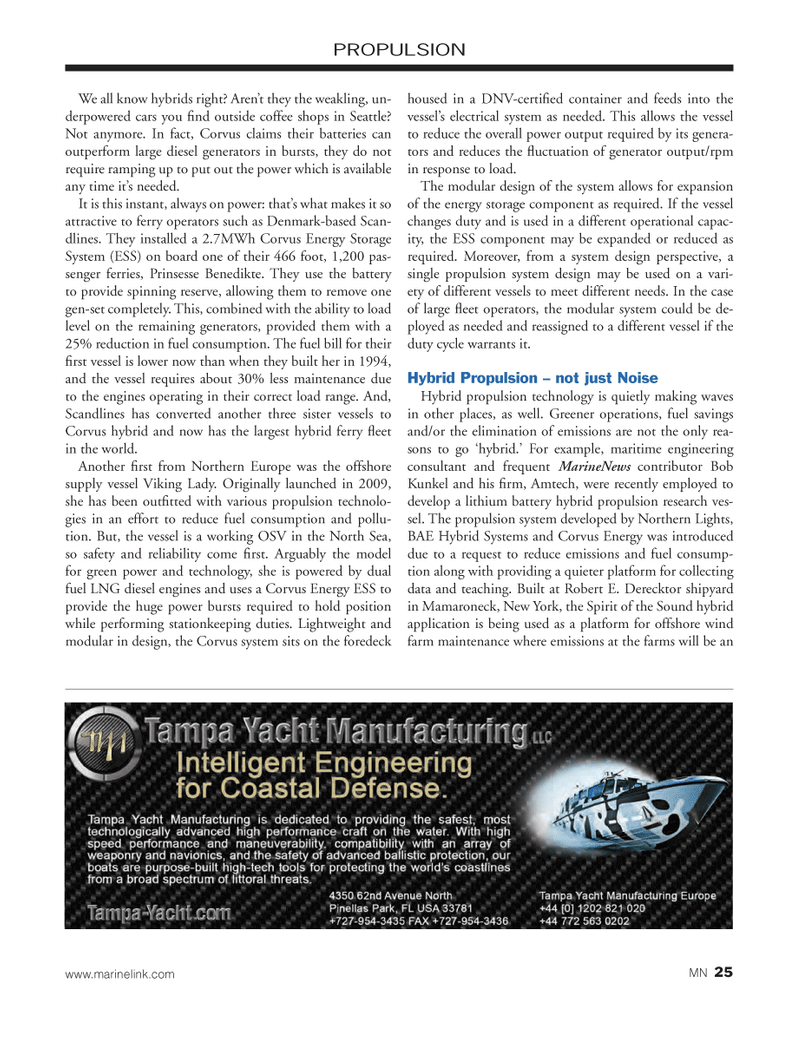
Page 25: of Marine News Magazine (December 2014)
Salvage & Spill Response
Read this page in Pdf, Flash or Html5 edition of December 2014 Marine News Magazine
PROPULSIONWe all know hybrids right? Aren?t they the weakling, un- derpowered cars you nd outside coffee shops in Seattle? Not anymore. In fact, Corvus claims their batteries can outperform large diesel generators in bursts, they do not require ramping up to put out the power which is available any time it?s needed. It is this instant, always on power: that?s what makes it so attractive to ferry operators such as Denmark-based Scan- dlines. They installed a 2.7MWh Corvus Energy Storage System (ESS) on board one of their 466 foot, 1,200 pas- senger ferries, Prinsesse Benedikte. They use the battery to provide spinning reserve, allowing them to remove one gen-set completely. This, combined with the ability to load level on the remaining generators, provided them with a 25% reduction in fuel consumption. The fuel bill for their rst vessel is lower now than when they built her in 1994, and the vessel requires about 30% less maintenance due to the engines operating in their correct load range. And, Scandlines has converted another three sister vessels to Corvus hybrid and now has the largest hybrid ferry eet in the world. Another rst from Northern Europe was the offshore supply vessel Viking Lady. Originally launched in 2009, she has been out tted with various propulsion technolo- gies in an effort to reduce fuel consumption and pollu- tion. But, the vessel is a working OSV in the North Sea, so safety and reliability come rst. Arguably the model for green power and technology, she is powered by dual fuel LNG diesel engines and uses a Corvus Energy ESS to provide the huge power bursts required to hold position while performing stationkeeping duties. Lightweight and modular in design, the Corvus system sits on the foredeck housed in a DNV-certi ed container and feeds into the vessel?s electrical system as needed. This allows the vessel to reduce the overall power output required by its genera- tors and reduces the uctuation of generator output/rpm in response to load. The modular design of the system allows for expansion of the energy storage component as required. If the vessel changes duty and is used in a different operational capac- ity, the ESS component may be expanded or reduced as required. Moreover, from a system design perspective, a single propulsion system design may be used on a vari- ety of different vessels to meet different needs. In the case of large eet operators, the modular system could be de- ployed as needed and reassigned to a different vessel if the duty cycle warrants it. Hybrid Propulsion ? not just Noise Hybrid propulsion technology is quietly making waves in other places, as well. Greener operations, fuel savings and/or the elimination of emissions are not the only rea- sons to go ?hybrid.? For example, maritime engineering consultant and frequent MarineNews contributor Bob Kunkel and his rm, Amtech, were recently employed to develop a lithium battery hybrid propulsion research ves- sel. The propulsion system developed by Northern Lights, BAE Hybrid Systems and Corvus Energy was introduced due to a request to reduce emissions and fuel consump- tion along with providing a quieter platform for collecting data and teaching. Built at Robert E. Derecktor shipyard in Mamaroneck, New York, the Spirit of the Sound hybrid application is being used as a platform for offshore wind farm maintenance where emissions at the farms will be an www.marinelink.com MN 25MN Dec14 Layout 18-31.indd 25MN Dec14 Layout 18-31.indd 2511/25/2014 11:55:07 AM11/25/2014 11:55:07 AM

 24
24

 26
26
